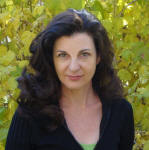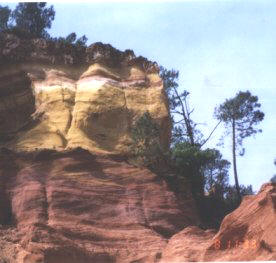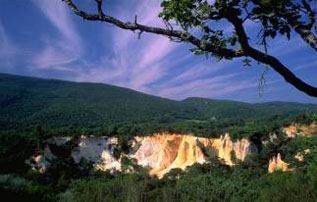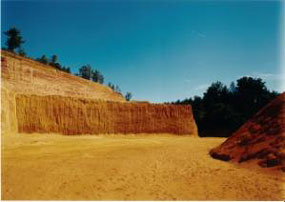Artist Linda Paul uses natural crushed stone and earth mixed with a bit of water and egg yolk to make paint for her egg tempera frescoes. Blues come from crushed lapis lazuli, greens from malachite and natural green earth found around Verona Italy. She uses fascinating colors which have been lost for hundreds of years and new colors which she has discovered in the Rocky Mountains. This medium is luminous and lasts for centuries.
See all available egg tempera paintings for sale.
Artist Linda Paul has discovered several new colors in her local area of the Rocky Mountains which have never been used before in the history of fresco painting. She received a grant from the Puffin Foundation for further research in this area. Paul collects rock samples and grinds them into a fine dust from which the impurities are then filtered. A small quantity of the crushed mineral is then mixed with egg yolk for painting. Each mineral has it own set of properties and idiosyncrasies particular to it.
Linda Paul is an American painter born in Canada. She is a self taught artist who discovered her talent in her 30's when she was between countries and had a year off to freely experiment without rules or boundaries. In this time, she played with various mediums but fell in love with old school egg tempera. Linda mixes actual crushed stones and minerals with a bit of egg yolk to create amazing colors. Blues come from crushed lapis lazuli, greens from malachite, and her ocher colors come from the ancient ochre mines in France and Italy. Linda Paul is an egg tempera rule breaker, no cross-hatching or tight lines for this artist. Some of her artworks are sculptures as well as paintings. She will first sculpt the artwork in low bas-relief before painting. Linda Paul's work has appeared in many galleries and shows, publications and on numerous book covers as well as being licensed for a number of products. She runs a reproduction studio which reproduces her fine art prints onto tile. She does not paint in any one style or subject matter. Her work runs the gamut from chunky realism to abstract and impressionist painting. Her inspirations come from nature combined with conceptual ideas. When asked what is her favorite painting, she responds "the next one I am going to paint!"  watch video of how to separate an egg for egg tempera paintings You also might like these works of art by artist Linda Paul
|





